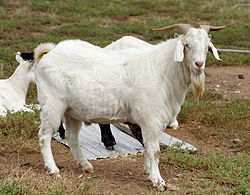Domestic goat
The domestic goat (Capra hircus or Capra aegagrus hircus[a]) is a domesticated mammal It comes from the wild goat.[b] A male goat is called a buck and a castrated goat is called a wether, a female is called a doe. Young goats are called kids.
People eat their meat, drink their milk, and use their fur and skin. With goat milk, cheese can be made, along with other dairy products like yogurt. Some farmers use goats to eat plants the farmers do not want, such as weeds. Other times, the goats are used to keep grasses and other plants from getting too tall. This also benefits the goat because they get plenty of food to eat.
The goat has cloven hooves, a long beard on its chin, a short tail that turns up, and horns that grow up from the head in an arc. The hair is straight with a woolly coat under it during winter. Goats have rectangular irises. They are one of the few species to have these unique eyes.[1]
The goat is about 70-120 cm (28-48 inches). They weigh from 45-54 kg (100-120 lb.) during adulthood.
The diet of the goat includes eating grass, leaves, shrubs, root vegetables, and other kinds of plants.[2] Some ranchers use goats to clear brush and unwanted plants from their pastures Goats living in the desert, where plants are quite hard to find, have been seen climbing trees to get food
Goats are smart and active. They enjoy playing with other goats and climbing They are social animals that may live in groups or herds
Domestic Goat Media
Horn cores from the Neolithic village of Atlit Yam, between 6900 and 6300 BC
Feral goats in a churchyard near Llandudno, Wales
Goat. Capra aegagrus hircus*Specimen of goat skeleton prepared by the bone maceration technique and on display at the Museum of Veterinary Anatomy FMVZ USP.*This file was published as the result of a partnership between the Museum of Veterinary Anatomy FMVZ USP, the RIDC NeuroMat and the Wikimedia Community User Group Brasil. This GLAM project is reported.*Photography: Mu
Goats grazing in an argan tree, Morocco
Goats establishing a dominance hierarchy through head butting
Herd browsing together in Japan
Moving a herd on a road in Ladakh
Notes
- ↑ Strictly speaking, domesticated breeds are not part of the Linnaean system of classification.
- ↑ Mitochondrial DNA reveal that domestic goat (Capra hircus) are genetically affected by two subspecies of bezoar (Capra aegagrus) H Mannen 1, Y Nagata, S Tsuji [1] Archived 2021-01-31 at the Wayback Machine
References
| Wikispecies has information on: Capra aegagrus hircus. |
| Wikimedia Commons has media related to Lua error in Module:Commons_link at line 62: attempt to index field 'wikibase' (a nil value).. |
- ↑ "Why do goats have rectangular pupils?". curiosity.com. Retrieved 2 November 2017.[dead link]
- ↑ "ANIMAL BYTES - Domestic Goat". seaworld.org. Archived from the original on 20 June 2010. Retrieved 19 May 2010.









